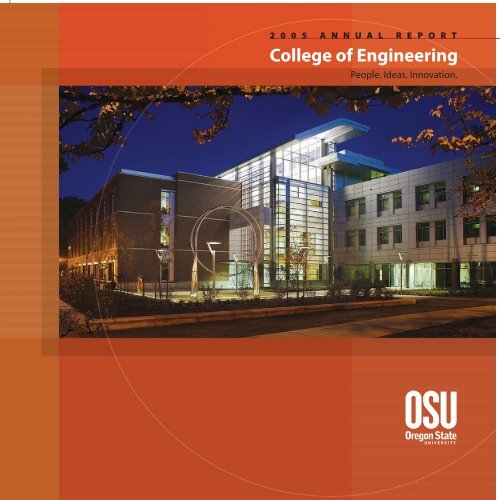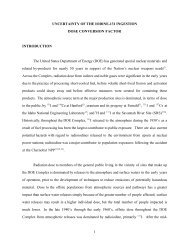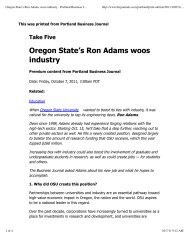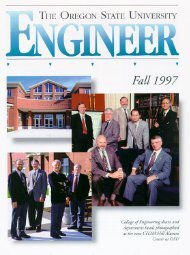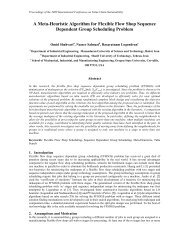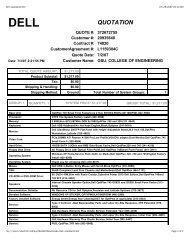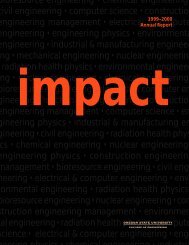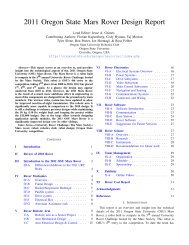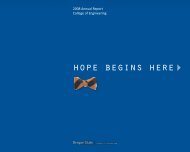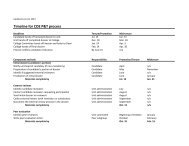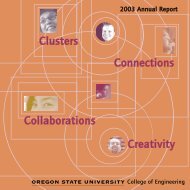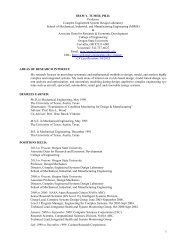2005 - College of Engineering - Oregon State University
2005 - College of Engineering - Oregon State University
2005 - College of Engineering - Oregon State University
Create successful ePaper yourself
Turn your PDF publications into a flip-book with our unique Google optimized e-Paper software.
2 0 0 5 A N N U A L R E P O R T<br />
<strong>College</strong> <strong>of</strong> <strong>Engineering</strong><br />
People. Ideas. Innovation.
It is good to<br />
have an end<br />
to journey<br />
toward;<br />
but it is the journey<br />
that matters, in the end.<br />
— U R S U L A K . L e G U I N
A Message from the Dean<br />
Here at <strong>Oregon</strong> <strong>State</strong> <strong>University</strong>,<br />
the <strong>College</strong> <strong>of</strong> <strong>Engineering</strong><br />
is in the midst <strong>of</strong> an<br />
incredible journey—<br />
a journey that is leveraging our long tradition<br />
<strong>of</strong> excellence and our culture <strong>of</strong> innovation,<br />
collaboration, and creativity to build a truly great<br />
engineering program made up <strong>of</strong> extraordinary<br />
people doing astonishing, innovative work.<br />
O r e g o n S t a t e U n i v e r s i t y <strong>College</strong> <strong>of</strong> <strong>Engineering</strong> <strong>2005</strong> Annual Report<br />
2<br />
Like most journeys, ours takes persistence and<br />
passion. The path includes high points with<br />
sweeping vistas, as well as lows where the going<br />
can be tough. But we welcome the challenges as<br />
we move toward the next milestones; this balance<br />
gives us energy for the next stage <strong>of</strong> the journey<br />
as we climb steadily toward becoming one <strong>of</strong> the<br />
top-25 engineering programs in the nation.<br />
During the last year, the people here at the <strong>College</strong><br />
have taken a great number <strong>of</strong> steps, working hard<br />
LEFT: In front <strong>of</strong> the new Kelley <strong>Engineering</strong><br />
Center, Dean Ron Adams sits behind the<br />
wheel <strong>of</strong> a prototype solar car designed by<br />
a multidisciplinary team <strong>of</strong> OSU students<br />
including Kathy VanWormer, Leif Schneider,<br />
Hai Yue Han, and Peter Kurahashi.<br />
RIGHT: The deepest lake in the nation,<br />
Crater Lake, was formed by the eruption<br />
<strong>of</strong> Mount Mazama more than 7,700<br />
years ago. It is just one <strong>of</strong> <strong>Oregon</strong>’s<br />
many natural treasures.
to pass significant milestones—including one <strong>of</strong> our greatest:<br />
the opening <strong>of</strong> the 153,000-sq.-ft. Kelley <strong>Engineering</strong><br />
Center, the sparkling new home <strong>of</strong> our School <strong>of</strong> Electrical<br />
<strong>Engineering</strong> and Computer Science. This “green” building,<br />
constructed using sustainable materials (see photo essay on<br />
p. 18), is the result <strong>of</strong> vision and generosity. Martin and<br />
Judy Kelley’s $20 million lead gift, in combination with<br />
public funding and additional private support, made the<br />
Kelley <strong>Engineering</strong> Center a reality—a home for innovation<br />
that will impact thousands <strong>of</strong> lives.<br />
In the months ahead, we will begin major renovations<br />
<strong>of</strong> several other engineering buildings—including historic<br />
Apperson Hall—so that our students, staff, faculty, and<br />
industry partners can work and learn in environments<br />
that foster communication, collaboration, and creativity.<br />
All the while, we continue to build our educational<br />
programs and expand our cutting-edge research. In this<br />
report, you’ll read about our successes: microreactors used<br />
for producing biodiesel, filtering blood, and generating<br />
hydrogen for fuel cells (see p. 8); buoys that turn ocean<br />
wave action into electricity (see p. 4); structural research<br />
on bridges that is saving the state <strong>of</strong> <strong>Oregon</strong> millions<br />
<strong>of</strong> dollars (see p. 14); the development <strong>of</strong> transparent<br />
transistors—a breakthrough poised to revolutionize the<br />
electronics industry (see p. 10); and more.<br />
Our alumni like Jen-Hsun “Jensen” Huang (see p. 20)<br />
have gone on to launch major companies like NVIDIA,<br />
providing engineering innovations, economic impact, and<br />
international leadership. Like Jensen, our current entrepreneurial<br />
students, including Tyler Morita (see p. 22), are<br />
starting their own companies here on campus as part <strong>of</strong> the<br />
Austin Entrepreneurship Program at Weatherford Hall, the<br />
largest residential entrepreneurial program in the nation.<br />
Other students are doing outstanding work, too, from building<br />
autonomous vehicles to helping clean up toxic waste<br />
sites to building solar-powered cars.<br />
I’m proud <strong>of</strong> each and every one <strong>of</strong> the people who are on<br />
this journey—proud <strong>of</strong> the path we’re blazing, together. This<br />
is a journey built on our legacy <strong>of</strong> excellence and inspired<br />
by great people, bright ideas, and phenomenal innovation.<br />
Here’s to another good year… and the next milestone.<br />
Ron Adams, Dean<br />
O r e g o n S t a t e U n i v e r s i t y <strong>College</strong> <strong>of</strong> <strong>Engineering</strong> <strong>2005</strong> Annual Report<br />
3
L A R G E - S C A L E E N E R G Y S Y S T E M S<br />
O r e g o n S t a t e U n i v e r s i t y <strong>College</strong> <strong>of</strong> <strong>Engineering</strong> <strong>2005</strong> Annual Report<br />
<strong>College</strong> <strong>of</strong> <strong>Engineering</strong> pr<strong>of</strong>essors Annette von Jouanne and<br />
Alan Wallace are committed to involving coastal communities<br />
in the wave energy project. “It’s the collaboration that will<br />
make this project successful,” they say.
THE POWER OF<br />
TEAMWORK<br />
Creating energy from ocean waves<br />
Reedsport, a sleepy logging town on the southern <strong>Oregon</strong> coast, may<br />
be getting a shot <strong>of</strong> new energy thanks to a partnership between the<br />
community, engineers at <strong>Oregon</strong> <strong>State</strong> <strong>University</strong>, state and federal<br />
agencies, and members <strong>of</strong> private industry.<br />
This past summer, Annette von Jouanne and<br />
Alan Wallace, pr<strong>of</strong>essors in OSU’s School <strong>of</strong><br />
Electrical <strong>Engineering</strong> and Computer Science, led<br />
the first <strong>of</strong> what will be several community meetings<br />
centered around bringing wave energy to the <strong>Oregon</strong><br />
coast. In front <strong>of</strong> a standing room only crowd, they<br />
answered questions about energy potential, new<br />
jobs, environmental consequences, advanced technology,<br />
and dependence on foreign energy sources.<br />
Recognized as national leaders <strong>of</strong> ocean wave<br />
energy, von Jouanne and Wallace have developed<br />
several direct drive ocean buoys capable <strong>of</strong> converting<br />
the power in ocean waves to electrical energy.<br />
The coast near Reedsport has been identified as the<br />
optimal site in the nation for wave energy development.<br />
The overall energy potential there is enough to<br />
power about 20 percent <strong>of</strong> the state’s total electricity<br />
needs, according to von Jouanne and Wallace, and<br />
it is believed that with proper location and planning,<br />
converting wave energy to electricity may be one <strong>of</strong><br />
the most environmentally benign ways to generate<br />
electrical power.<br />
“Ocean waves have tremendous potential as an energy<br />
source,” von Jouanne says. “The energy density<br />
in water is much higher than it is in air. We can get<br />
more power with less space, and we can know within<br />
a 10-hour window what our energy capabilities are,<br />
and we can match them to the need.”<br />
The OSU-developed buoys are designed to be<br />
anchored 1-2 miles <strong>of</strong>fshore in water depths greater<br />
than 100 feet. At about 15 feet across by 12 feet<br />
tall, the buoys will sit neutrally buoyant in the water,<br />
and will be almost impossible to see from land with<br />
the naked eye. The research team pictures an array<br />
<strong>of</strong> buoys, or wave park, placed within a sectioned<br />
<strong>of</strong>f area <strong>of</strong> a yet to be determined size, however, it<br />
is estimated that 10 square miles could power the<br />
entire state <strong>of</strong> <strong>Oregon</strong>.<br />
“The key is creating a survivable, reliable, efficient<br />
system,” von Jouanne says <strong>of</strong> the buoys. “The ocean<br />
is very destructive, but we are at a point where we<br />
believe the buoys can be manufactured to survive<br />
the harsh environment.”<br />
O r e g o n S t a t e U n i v e r s i t y <strong>College</strong> <strong>of</strong> <strong>Engineering</strong> <strong>2005</strong> Annual Report
LEFT: Reedsport, <strong>Oregon</strong><br />
already has much <strong>of</strong> the<br />
infrastructure needed for a<br />
wave energy facility intact,<br />
including this inactive<br />
paper mill north <strong>of</strong> town.<br />
BELOW: A National Science<br />
Foundation graphic <strong>of</strong><br />
OSU’s direct drive buoy.<br />
Members <strong>of</strong> the community<br />
gather to learn<br />
more about wave energy<br />
in <strong>Oregon</strong>.<br />
O r e g o n S t a t e U n i v e r s i t y <strong>College</strong> <strong>of</strong> <strong>Engineering</strong> <strong>2005</strong> Annual Report<br />
Wallace adds that the development <strong>of</strong> wave energy is currently<br />
15-20 years behind wind energy, a technology that is just reaching<br />
its optimal performance. He says that just like wind energy,<br />
wave systems will be expensive at first then drop in price as the<br />
industry becomes competitive. Currently, there are operating<br />
wave energy systems in Europe, but the technology is different<br />
than that being developed at OSU.<br />
“This is groundbreaking research that can be <strong>of</strong> enormous value<br />
to society, and it’s amazing all <strong>of</strong> the people who want to get<br />
involved,” Wallace says.<br />
The <strong>College</strong> <strong>of</strong> <strong>Engineering</strong>, the <strong>Oregon</strong> Department <strong>of</strong> Energy,<br />
and the Electric Power Research Institute are hoping to establish<br />
a wave energy conversion research, development, and<br />
demonstration center at a disused paper mill located next to<br />
the electrical substation in Gardiner, just north <strong>of</strong> Reedsport.<br />
The mill, which has been inactive for several years, already has<br />
a number <strong>of</strong> features that could substantially reduce the cost<br />
<strong>of</strong> the project, including available power transmission capability<br />
and an existing outflow pipe. The pipe could be used to house<br />
the power cable that would run from the buoys to the Gardiner<br />
power station where the energy would enter into the grid.
“It could be a whole new<br />
industry. We could be<br />
the nation’s wave energy<br />
headquarters. In a few<br />
years time on the <strong>Oregon</strong><br />
coast there could be<br />
wave parks generating<br />
power back onto the grid<br />
and providing jobs for<br />
the people living in the<br />
region.”<br />
— ANNETTE VON JOUANNE<br />
The facility would create a need for<br />
new local jobs, both in the construction<br />
phase and in daily operations, promote<br />
development, and add to the state’s<br />
goal <strong>of</strong> energy self-sufficiency. It would<br />
receive direction and support from OSU<br />
and its Hatfield Marine Science Center<br />
in Newport. In addition, the <strong>College</strong> <strong>of</strong><br />
<strong>Engineering</strong> is home to the Motor Systems<br />
Resource Facility, the highest-power energy<br />
systems laboratory at any university in<br />
the nation, and the O. H. Hinsdale Wave<br />
Research Laboratory. Both resources would<br />
be available and used by researchers<br />
working at the site.<br />
“It could be a whole new industry,” says<br />
von Jouanne. “We could be the nation’s<br />
wave energy headquarters. In a few years<br />
time on the <strong>Oregon</strong> coast there could be<br />
wave parks generating power back onto<br />
the grid and providing jobs for the people<br />
living in the region.”<br />
The response to the project has been<br />
tremendous. Stories about the research,<br />
and the first community meetings, have<br />
been picked up by national press and run<br />
in publications ranging from engineering<br />
trade journals to the Washington Post and<br />
Popular Mechanics. Von Jouanne says she<br />
is constantly responding to phone calls<br />
and e-mails about the project, and the<br />
possibility for similar wave energy generation<br />
sites elsewhere.<br />
“The really great part is sharing the vision<br />
with others, with our students, and with<br />
the public,” von Jouanne says. “People are<br />
very receptive, and our involved students<br />
are being heavily recruited by industry.”<br />
For the past two years von Jouanne and<br />
Wallace have been funding the project<br />
with a $270,000 grant from the National<br />
Science Foundation and additional funding<br />
from the <strong>Oregon</strong> Sea Grant, the<br />
Department <strong>of</strong> Energy, Columbia Power<br />
Technologies, and regional utilities. The<br />
next phase <strong>of</strong> the project will require<br />
about $5 million. Language has been<br />
added to state and federal energy bills<br />
that could funnel money toward the<br />
project, however von Jouanne and Wallace<br />
are also actively looking for industry partners<br />
and private funding.<br />
O r e g o n S t a t e U n i v e r s i t y <strong>College</strong> <strong>of</strong> <strong>Engineering</strong> <strong>2005</strong> Annual Report
O N A M I @ O S U<br />
Micr<strong>of</strong>luidics<br />
big things come<br />
in small packages<br />
O r e g o n S t a t e U n i v e r s i t y <strong>College</strong> <strong>of</strong> <strong>Engineering</strong> <strong>2005</strong> Annual Report<br />
LEFT: Pr<strong>of</strong>essor Goran Jovanovic says micr<strong>of</strong>luidic systems aimed<br />
at producing alternatives to fossil fuels may provide a vehicle for<br />
energy independence in areas <strong>of</strong> the United <strong>State</strong>s.<br />
ABOVE: Examples <strong>of</strong> OSU-developed microchannels and a<br />
prototype biodiesel microprocessor.
That’s the driving force behind the <strong>Oregon</strong> Nanoscience and Microtechnologies Institute,<br />
a powerful collaboration between <strong>Oregon</strong> <strong>State</strong> <strong>University</strong>, Portland <strong>State</strong> <strong>University</strong>,<br />
<strong>University</strong> <strong>of</strong> <strong>Oregon</strong>, the Pacific Northwest National Laboratory, the state <strong>of</strong> <strong>Oregon</strong>,<br />
and the high technology industry in <strong>Oregon</strong> and southwest Washington.<br />
OSU engineering faculty, working on the micr<strong>of</strong>luidics<br />
side <strong>of</strong> ONAMI, believe that science on a small scale<br />
can achieve big results with worldwide appeal. By using<br />
microchannels developed and built in OSU’s Dept. <strong>of</strong><br />
Industrial and Manufacturing <strong>Engineering</strong> to intensify<br />
and more tightly control the processes that occur during<br />
chemical reactions, faculty are achieving unprecedented<br />
results.<br />
A few examples:<br />
• Goran Jovanovic, a pr<strong>of</strong>essor in the Dept. <strong>of</strong><br />
Chemical <strong>Engineering</strong>, is producing biodiesel by<br />
combining oil from seed crops with alcohol in tiny<br />
microchannels. The microchannels have no moving<br />
parts, do not require external energy, and can be<br />
stacked to increase production. Current data suggests<br />
that a microchannel reactor the size <strong>of</strong> a suitcase could<br />
produce one million gallons <strong>of</strong> biodiesel a year.<br />
• Jovanovic is also using microchannels to remove<br />
sulphur from conventional petroleum products like<br />
gasoline and diesel, for use in fuel cells. When burned,<br />
or combusted in an engine, sulphur produces sulphur<br />
dioxide, an environmental pollutant also know as acid<br />
rain. Removing sulphur from petroleum products may<br />
increase fuel economy, and help to reduce pollution<br />
leading to global warming.<br />
• Greg Rorrer, also a pr<strong>of</strong>essor in the Dept. <strong>of</strong> Chemical<br />
<strong>Engineering</strong>, is putting sugars and starches through a<br />
microreactor to produce hydrogen. The process gives<br />
Rorrer very tight control over the time the substances<br />
are in the reactor. This technology may help farmers<br />
make hydrogen for use in fuel cells from the very<br />
substances they are growing.<br />
• OSU engineering alumni Kay Altman and David<br />
Browning (pictured below) are helping produce a<br />
kidney dialysis unit developed by OSU engineers<br />
associated with ONAMI. The tiny device is incredibly<br />
efficient, and will enable dialysis patients to treat<br />
themselves at home while they sleep.<br />
• Rich Peterson, a pr<strong>of</strong>essor in the Dept. <strong>of</strong> Mechanical<br />
<strong>Engineering</strong>, is leading a push along with colleague<br />
Deborah Pence in the development <strong>of</strong> a personal heat<br />
pump. Previous attempts at personal cooling systems<br />
have required 10-20 lbs. <strong>of</strong> batteries. The <strong>College</strong>’s<br />
system uses waste heat from a fuel cell to drive the<br />
cooling process. This replaces the heavy battery-based<br />
power system and results in a lighter, more compact<br />
portable cooling device.<br />
O r e g o n S t a t e U n i v e r s i t y <strong>College</strong> <strong>of</strong> <strong>Engineering</strong> <strong>2005</strong> Annual Report
O N A M I @ O S U<br />
O r e g o n S t a t e U n i v e r s i t y <strong>College</strong> <strong>of</strong> <strong>Engineering</strong> <strong>2005</strong> Annual Report<br />
10<br />
ABOVE: Perfectly clear, see An interdisciplinary team <strong>of</strong> OSU faculty and students hold up samples <strong>of</strong> transparent<br />
electronics developed through a collaboration between OSU pr<strong>of</strong>essor <strong>of</strong> electrical engineering John Wager<br />
(second from right), OSU pr<strong>of</strong>essor <strong>of</strong> chemistry Doug Keszler (right), and others. Pictured at left are graduate<br />
student Emma Kettenring and development engineer Chris Tasker.<br />
OPPOSITE: Glass slides coated with transparent electronics sit in a petri dish, and a sputtering machine built by<br />
Chris Tasker glows purple during thin film deposition.
See-Through Electronics Will Enable a New Generation <strong>of</strong> Devices<br />
When OSU Electrical <strong>Engineering</strong><br />
pr<strong>of</strong>essor John Wager talks about his<br />
research, you can hear excitement<br />
edging his voice. No wonder. He’s in<br />
the position every researcher dreams<br />
about: standing on the threshold <strong>of</strong> a<br />
breakthrough that could revolutionize<br />
an entire industry—in this case,<br />
the electronics industry.<br />
“I think we’re onto something huge here at<br />
<strong>Oregon</strong> <strong>State</strong>,” Wager says. “And other people<br />
are beginning to sense that now.”<br />
The term “huge” doesn’t exactly fit<br />
Wager’s research, because he and<br />
his team <strong>of</strong> graduate students are<br />
working at the molecular level, and<br />
the end result is, well—invisible. But<br />
that’s the ultimate goal: electronics<br />
that are so crystal clear you can see<br />
right through them. Which makes<br />
any transparent surface a potential<br />
location for electronic devices. And<br />
that’s indeed huge.<br />
In 2003, working closely with<br />
OSU pr<strong>of</strong>essors Doug Keszler<br />
(chemistry) and Janet Tate (physics), Wager’s<br />
group developed the world’s first transparent<br />
transistor (the transistor is the most fundamental<br />
electronic component). This year, Wager and his<br />
multidisciplinary team developed the world’s first<br />
simple integrated circuit (a ring oscillator) that<br />
will also be transparent.<br />
“When we do that, I think people will realize this<br />
technology is ready for prime time,” Wager says<br />
with a smile.<br />
Already Wager’s work is drawing the attention<br />
<strong>of</strong> prestigious research journals and major news<br />
media: Nature, NPR’s Science Friday, CNN, the<br />
journal Science, Wired Magazine, and others.<br />
How did Wager, who’s been at OSU for 21 years,<br />
arrive at this research breakthrough Ever modest,<br />
Wager is quick to credit his graduate students,<br />
his OSU collaborators, his development engineer,<br />
Chris Tasker, and a good dose <strong>of</strong> luck.<br />
“You get lucky every once in a while,” he says.<br />
“We were trying to figure out how to get electrons<br />
to move through various combinations <strong>of</strong><br />
chemicals to direct electricity in electronic applications<br />
and were just in the right place at the<br />
right time asking the right questions. I also have<br />
great graduate students, and Chris Tasker—he’s<br />
the brains behind our entire lab.”<br />
O r e g o n S t a t e U n i v e r s i t y <strong>College</strong> <strong>of</strong> <strong>Engineering</strong> <strong>2005</strong> Annual Report<br />
11
O r e g o n S t a t e U n i v e r s i t y <strong>College</strong> <strong>of</strong> <strong>Engineering</strong> <strong>2005</strong> Annual Report<br />
Inside John Wager’s lab,<br />
Celia Hung and fellow graduate<br />
students are part <strong>of</strong> a flurry<br />
<strong>of</strong> research activity that’s<br />
gained national attention.<br />
Wager (opposite page) and<br />
his students have developed<br />
the world’s first transparent<br />
integrated circuit.<br />
It is within Wager’s sprawling fourth floor<br />
lab that materials science, chemistry, physics,<br />
electrical engineering, and perseverance<br />
converged to help his team discover that<br />
common and cheap materials, zinc oxide and<br />
tin oxide, could be used to create transparent<br />
thin film transistors. They then combined<br />
these two elements and discovered that a<br />
new material, Zinc Tin Oxide (ZTO), had even<br />
greater electrical properties, including much<br />
higher electron mobility.<br />
“We just stumbled onto this new material,<br />
and although zinc tin oxide is an amorphous<br />
structure, its electrical mobility is quite<br />
good,” Wager says, ticking <strong>of</strong>f a list <strong>of</strong> other<br />
attributes: very robust (scratch resistant),<br />
high chemical stability (facilitates etching),<br />
low cost, and a smooth surface. The surface<br />
smoothness, he says, is “very, very nice from<br />
a manufacturing point <strong>of</strong> view.” Traditionally,<br />
silicon has been used for electronics because<br />
its crystalline structure facilitates efficient<br />
electron flow.<br />
12
But silicon requires high temperatures<br />
to produce, is too expensive for largearea<br />
and low-cost applications, is highly<br />
brittle, and is anything but transparent.<br />
Wager’s team has discovered that zinc<br />
tin oxide is not the only material that<br />
works well for this type <strong>of</strong> electronics.<br />
“We’ve found a sweet spot in the<br />
periodic table,”<br />
he says. “Which<br />
points to a new<br />
class <strong>of</strong> electronic<br />
materials.” His<br />
group is currently<br />
working with zinc<br />
indium oxide,<br />
another member<br />
<strong>of</strong> this new materials<br />
class.<br />
Unlike silicon, these new materials can<br />
be produced at very low temperatures<br />
and are also flexible, making them<br />
applicable to glass, plastics, and bendable<br />
materials, such as maps<br />
and foils.<br />
Wager’s work could dramatically impact<br />
organic light emitting devices, leading<br />
to displays that are brighter, crisper,<br />
and consume less power. “Our materials<br />
might be the solution to the electronic<br />
back-plane driver challenge <strong>of</strong> this projected<br />
$10-15 billion market,” he says.<br />
Solar cell technology would also be<br />
improved, as well as a myriad <strong>of</strong> other<br />
applications ranging from security and<br />
safety to energy independence.<br />
For example, the infrared or optical<br />
transparency <strong>of</strong> a coating on the<br />
window <strong>of</strong> a home or <strong>of</strong>fice could be<br />
electronically controlled, to let in more<br />
or less heat and light, depending on the<br />
weather. A warning could flash inside a<br />
car’s windshield glass if sensors detect<br />
an object in the street ahead. Invisible<br />
burglar alarms could be placed on glass.<br />
Printers and copy machines could have<br />
electronics applied on the glass, dramatically<br />
reducing<br />
their overall size.<br />
Already Wager’s work is<br />
drawing the attention <strong>of</strong><br />
prestigious research journals<br />
and major news media:<br />
Nature, NPR’s Science Friday,<br />
CNN, the journal Science,<br />
Wired Magazine, and others.<br />
“As soon as you<br />
start letting your<br />
mind wander,<br />
there are a lot <strong>of</strong><br />
potential applications<br />
out there,”<br />
Wager says. But<br />
his job, he says,<br />
is to develop the<br />
basic materials and device technology,<br />
for which he currently has six patents<br />
pending, and then let private industry<br />
incorporate this technology into new<br />
devices and products.<br />
Wager’s team has just inked an<br />
exclusive licensing agreement with<br />
Hewlett-Packard Co. and is working<br />
with the <strong>Oregon</strong> Nanoscience and<br />
Microtechnologies Institute (ONAMI) to<br />
help commercialize the OSU research.<br />
What else could Wager wish for at this<br />
point in his career He’d like to secure<br />
funding to hire another faculty member<br />
with expertise in his research area.<br />
This would speed development <strong>of</strong> his<br />
“invisible” research, which is already<br />
casting a growing shadow across the<br />
electronics industry.<br />
O r e g o n S t a t e U n i v e r s i t y <strong>College</strong> <strong>of</strong> <strong>Engineering</strong> <strong>2005</strong> Annual Report<br />
13
T H E K I E W I T C E N T E R F O R I N F R A S T R U C T U R E + T R A N S P O R T A T I O N<br />
Strong Research,<br />
Stable Structures<br />
O r e g o n S t a t e U n i v e r s i t y <strong>College</strong> <strong>of</strong> <strong>Engineering</strong> <strong>2005</strong> Annual Report<br />
Chris Higgins and his team <strong>of</strong><br />
research students build their<br />
own concrete girders at the<br />
Large-Scale Structural Testing<br />
Laboratory. The <strong>College</strong> <strong>of</strong><br />
<strong>Engineering</strong> is working toward<br />
expanding the lab to include<br />
a strong wall and other<br />
testing features.<br />
14
Keeping <strong>Oregon</strong>’s Infrastructure Up and Running<br />
During regular inspections in 2000, <strong>Oregon</strong> Department <strong>of</strong> Transportation (ODOT) personnel<br />
noticed something disturbing about the vintage concrete bridges all over <strong>Oregon</strong>. From the<br />
Powder River in the northeast to the Rogue River in southern <strong>Oregon</strong>, the bridges were cracked.<br />
Of the 1,800 concrete girder bridges listed in the state<br />
database roughly 500 showed visible cracks, many <strong>of</strong> those<br />
on Interstate 5 and Interstate 84, the main north-south<br />
and east-west corridors in the state.<br />
“From just about anywhere in the state, you can’t<br />
travel east or west, north or south without crossing<br />
one <strong>of</strong> these bridges,” says Chris Higgins, a pr<strong>of</strong>essor<br />
in OSU’s Dept. <strong>of</strong> Civil, Construction, and Environmental<br />
<strong>Engineering</strong>. “It has a large scope and is an expensive<br />
problem.”<br />
ODOT took immediate action. The agency imposed load<br />
limitations on several bridges, closed others, and commissioned<br />
Higgins and his team at the <strong>College</strong> <strong>of</strong> <strong>Engineering</strong><br />
to help the state analyze the severity <strong>of</strong> the cracks, assess<br />
the remaining capacity, and predict the remaining life <strong>of</strong><br />
these bridges.<br />
“I was pleased to partner with OSU in development <strong>of</strong> the<br />
testing plan, and to be part <strong>of</strong> the technical advisory committee<br />
for the research project,” says Ray Mabey, deputy<br />
director <strong>of</strong> ODOT’s OTIA III <strong>State</strong> Bridge Delivery Program.<br />
“Some <strong>of</strong> the research methods and results <strong>of</strong> this study<br />
will be recognized nationally.”<br />
The majority <strong>of</strong> the bridges affected were built in the<br />
1950s. At the time, engineers were employing very lean<br />
and efficient designs, specifying only that material which<br />
was necessary. When they began using standardized<br />
deformed reinforcing bars, a new technology at the time,<br />
they deviated from their past successful practice when<br />
detailing the reinforcing within the bridges, Higgins says.<br />
Prior to cracking, the concrete carries the load on the<br />
bridge. Once cracked, the load is transferred to the steel<br />
rebar imbedded in the structure. As trucks became heavier<br />
and more frequent, the load on the bridges increased and<br />
large diagonal cracks formed. Because the bridges contain<br />
less steel than required by current codes, the structures<br />
were <strong>of</strong> concern to engineers.<br />
“We undertook field work and full-scale laboratory<br />
testing and analysis to determine how the<br />
bridge members were behaving,” Higgins says.<br />
“We studied the load effects and found that it<br />
was a matter <strong>of</strong> both shear and moment acting<br />
on the section. The problem was a conspiracy <strong>of</strong><br />
two force effects, and not a lone gunman.”<br />
Higgins and his research team completed field data collection<br />
on four <strong>Oregon</strong> bridges, and built 44 full-size concrete<br />
girders to 1950s specifications for testing at the Large-<br />
Scale Structural Testing Laboratory housed in the <strong>College</strong><br />
<strong>of</strong> <strong>Engineering</strong>’s O.H. Hinsdale Wave Research Laboratory.<br />
The laboratory contains a strong-floor that enabled the<br />
team to carry out full-scale experimental tests on the fourfoot<br />
thick girders, and the first-ever tests <strong>of</strong> real-size bridge<br />
girders failing under moving loads.<br />
Higgins’ team developed a reliability-based assessment<br />
methodology for ODOT to use on a bridge-by-bridge basis,<br />
and provided ODOT tools to determine the<br />
residual load carrying capacity.<br />
“Once you make that assessment you can decide what<br />
needs to be done, if anything, to ensure the safety <strong>of</strong> the<br />
structure,” Higgins said. “All this work is about protecting<br />
the safety <strong>of</strong> the traveling public, making the best use <strong>of</strong><br />
public transportation investments, and keeping <strong>Oregon</strong> up<br />
and running.”<br />
O r e g o n S t a t e U n i v e r s i t y <strong>College</strong> <strong>of</strong> <strong>Engineering</strong> <strong>2005</strong> Annual Report<br />
15
F A C U L T Y<br />
José Reyes<br />
Managing Major Growth in Nuclear <strong>Engineering</strong><br />
OSU Nuclear <strong>Engineering</strong> faculty,<br />
José Reyes, Brian Woods, Qiao<br />
Wu, and Todd Palmer enjoy a light<br />
moment near campus. This faculty<br />
team, their staff, and a burgeoning<br />
number <strong>of</strong> students have helped<br />
the OSU Nuclear <strong>Engineering</strong> program<br />
gain a No. 9 national ranking.<br />
O r e g o n S t a t e U n i v e r s i t y <strong>College</strong> <strong>of</strong> <strong>Engineering</strong> <strong>2005</strong> Annual Report<br />
16<br />
After a sabbatical in Vienna, Austria working with the<br />
United Nations to develop safer passive nuclear reactors,<br />
José Reyes, the Henry W. and Janice J. Schuette Chair in<br />
Nuclear <strong>Engineering</strong> and Radiation Health Physics, returned<br />
to OSU last winter to a flurry <strong>of</strong> good news:<br />
• U.S. News and World Report ranked OSU’s<br />
nuclear engineering program No. 9 in the nation<br />
• student enrollment in the department was way up,<br />
and climbing<br />
• national interest in nuclear power was the<br />
highest in decades<br />
• and the <strong>College</strong> selected Reyes as the new<br />
department head<br />
To top it <strong>of</strong>f, OSU was selected as one <strong>of</strong> five universities<br />
to play a key role in a research collaboration with the<br />
Idaho National Laboratory (INL), which will bring the<br />
department approximately $12 million in funding<br />
over 10 years.<br />
“That was quite a coup,” says Reyes, who will be<br />
co-director, along with pr<strong>of</strong>essor Todd Palmer, <strong>of</strong><br />
the Academic Center <strong>of</strong> Excellence for Thermal<br />
Fluids and Reactor Safety — the OSU part <strong>of</strong> the<br />
INL project.<br />
All the growth and good news is stretching the department,<br />
both physically and personnel wise. So Reyes<br />
and colleagues are making big plans to meet the<br />
growing demand for nuclear engineering graduates.<br />
“The average age <strong>of</strong> workers at the nation’s 102 nuclear<br />
power plants is 52,” Reyes says. “There’s a tremendous need<br />
for new nuclear engineers and for medical physicists, who<br />
design radiation therapies.”<br />
Reyes’s department is soliciting funds to construct a new<br />
wing on the OSU Radiation Center to house a new Medical<br />
Physics program, a 300-seat auditorium, larger classrooms,<br />
and faculty <strong>of</strong>fices. The new wing would also free up existing<br />
space for desperately needed laboratories.<br />
“We’ve been converting lab space to <strong>of</strong>fice space to accommodate<br />
growth,” he says. “But we can’t keep doing that.”<br />
The ultimate change The department will be renamed the<br />
OSU School <strong>of</strong> Nuclear Science and <strong>Engineering</strong> to better<br />
reflect its leadership position as one <strong>of</strong> the top nuclear<br />
programs in the world.
F A C U L T Y<br />
MusicStrands<br />
Sing Loud, Sing Proud<br />
Cranking up the volume at the <strong>College</strong> <strong>of</strong> <strong>Engineering</strong><br />
I love rock n’ roll<br />
So put another dime<br />
in the jukebox, baby<br />
I love rock n’ roll<br />
So come an’ take your<br />
time an’ dance with me<br />
Joan Jett, the musical bombshell popular<br />
during the 1980s, sang “I Love Rock n’<br />
Roll,” and thousands <strong>of</strong> rock fans loved<br />
her for it. She belted out the lyrics in a<br />
loud unapologetic voice accompanied by<br />
a fast guitar, heavy base, and memorable<br />
drumbeat. Her music filled a niche in the<br />
male dominated world <strong>of</strong> rock and roll<br />
punk. Today, Jett’s unique sound is largely<br />
confined to the classic rock station, and<br />
the potential fans who just might love her<br />
music may never even hear her sing.<br />
MusicStrands, a new music recommendation<br />
s<strong>of</strong>tware company, could change that.<br />
The s<strong>of</strong>tware, which<br />
began as an idea at the<br />
<strong>College</strong> <strong>of</strong> <strong>Engineering</strong>,<br />
uses artificial intelligence<br />
to identify an individual’s<br />
listening patterns and<br />
generate new musical<br />
recommendations.<br />
“It’s all about music discovery,” says<br />
Jon Herlocker, a pr<strong>of</strong>essor in the School<br />
<strong>of</strong> Electrical <strong>Engineering</strong> and Computer<br />
Science, and one <strong>of</strong> the masterminds<br />
behind MusicStrands. “We asked, ‘How can<br />
we help people discover new music’ and<br />
what we’ve come up with is a way to assist<br />
in the creation <strong>of</strong> communities <strong>of</strong> interest<br />
around music.”<br />
Matt McLaughlin, Herlocker’s former<br />
master’s student and the current vice<br />
president <strong>of</strong> product innovations at<br />
MusicStrands, adds that the company<br />
is centered around helping individuals<br />
connect with one another through music.<br />
MusicStrands has <strong>of</strong>fices in Barcelona,<br />
Spain, and Corvallis, Ore. It employs<br />
44 people, several <strong>of</strong> whom graduated,<br />
taught, or conducted research at <strong>Oregon</strong><br />
<strong>State</strong> <strong>University</strong>’s <strong>College</strong> <strong>of</strong> <strong>Engineering</strong>.<br />
“OSU is where we all met,”<br />
says 25-year-old McLaughlin.<br />
“The <strong>College</strong> <strong>of</strong> <strong>Engineering</strong> is<br />
very important as a connecting<br />
point for new ideas.”<br />
Matt McLaughlin (left) and Jon<br />
Herlocker describe the combination<br />
<strong>of</strong> music and artificial intelligence<br />
in MusicStrands.com as “fun.”<br />
The company continues to receive<br />
national media attention.<br />
O r e g o n S t a t e U n i v e r s i t y <strong>College</strong> <strong>of</strong> <strong>Engineering</strong> <strong>2005</strong> Annual Report<br />
17
Kelley <strong>Engineering</strong> Center<br />
A NEW HOME FOR INNOVATION, DESIGNED FOR COLLABORATION AND CREATIVITY.<br />
O r e g o n S t a t e U n i v e r s i t y <strong>College</strong> <strong>of</strong> <strong>Engineering</strong> <strong>2005</strong> Annual Report<br />
18<br />
Thanks to a $20 million lead gift from Judy and Martin Kelley<br />
(Civil <strong>Engineering</strong>, 1950), an additional $20 million in matching<br />
public funds from the citizens <strong>of</strong> <strong>Oregon</strong>, and $5 million<br />
in private gifts, the 153,000-sq.-ft. Kelley <strong>Engineering</strong> Center<br />
provides a dynamic new working and learning<br />
environment for students, faculty, and staff <strong>of</strong><br />
the OSU School <strong>of</strong> Electrical <strong>Engineering</strong><br />
and Computer Science.
A L U M N I<br />
Visualizing the Big Picture<br />
Jen-Hsun Huang<br />
CEO, President, and Co-founder<br />
It was in a circuit design class taught by <strong>Oregon</strong> <strong>State</strong> pr<strong>of</strong>essor<br />
Donald Amort that Jen-Hsun “Jensen” Huang<br />
(BS, 1984) first learned how to see and understand the<br />
big picture before diving into the details. It’s a lesson he<br />
uses everyday as co-founder and CEO <strong>of</strong> NVIDIA, the world<br />
leader in graphics processing technologies.<br />
“We had a hunch 13 years ago when we founded NVIDIA,<br />
that visualizing information—the visual experience you have<br />
with your computer, or any digital device—was going to be<br />
as important, if not more important, than the computational<br />
experience,” Huang says. “That hunch was right. We’ve<br />
now entered the post-computer era, the experiential era.”<br />
O r e g o n S t a t e U n i v e r s i t y <strong>College</strong> <strong>of</strong> <strong>Engineering</strong> <strong>2005</strong> Annual Report<br />
“I was a sophomore engineering student, trained to analyze<br />
things down to three decimal points, and here was pr<strong>of</strong>essor<br />
Amort up at the board using such rough numbers that<br />
it was incredibly<br />
uncomfortable<br />
for me,” Huang<br />
says. “But in a<br />
way, how he<br />
taught that<br />
class really<br />
set me free.”<br />
“<strong>Oregon</strong> <strong>State</strong> is a wonderful<br />
school. The pr<strong>of</strong>essors have<br />
a balance <strong>of</strong> practicality and<br />
theory. They teach the theory,<br />
but are always trying to help<br />
you apply it.”<br />
As leader <strong>of</strong> a wildly successful semiconductor<br />
company with more than 2,500 employees and annual<br />
sales in excess <strong>of</strong> $2 billion, Huang says he has to focus on<br />
the big picture, and credits Amort with teaching him how<br />
to do that.<br />
“In my job, I have to analyze problems very quickly,” Huang<br />
says. “If you focus on the most important variables and<br />
don’t get bogged down by the minutia, it’s amazing what<br />
you can accomplish.”<br />
In his 42 years, Huang has accomplished much. The graphics<br />
processing units his company produces are found in<br />
products ranging from Micros<strong>of</strong>t’s Xbox and Motorola’s new<br />
3G cell phones to NASA workstations that help navigate<br />
the Mars Rover.<br />
Huang was raised in Taiwan and Thailand, son <strong>of</strong> an<br />
engineering father. At age 10, he came to the U.S., where<br />
an aunt and uncle in Tacoma, Wash. selected what they<br />
thought was a prep school in eastern Kentucky for Huang<br />
to attend. The school turned out to be closer to a reform<br />
school, where Huang shared a dorm room with a tattooed<br />
17-year-old who sported scars from knife wounds and<br />
couldn’t read. It was there that Huang learned about work<br />
ethic, scrubbing toilets and sweeping the halls every day<br />
after school.<br />
But it was at <strong>Oregon</strong> <strong>State</strong>, in an electromagnetics class<br />
taught by pr<strong>of</strong>essor Phil Magnuson, where Huang met his<br />
20
Jen-Hsun Huang’s journey from standout <strong>Oregon</strong><br />
<strong>State</strong> engineering student to leader <strong>of</strong> a highly<br />
successful Silicon Valley company is an example<br />
<strong>of</strong> what can happen when engineering and<br />
entrepreneurship come together.<br />
wife, Lori, when they were paired <strong>of</strong>f as lab partners. “That was the most important, single<br />
event <strong>of</strong> OSU, and <strong>of</strong> my life,” he says.<br />
Huang believes the <strong>College</strong>’s emphasis on basic principles, work ethic, collaboration, and<br />
business acumen are all important assets in the drive toward becoming a top-25 engineering<br />
program. “<strong>Oregon</strong> <strong>State</strong> is a wonderful school. The pr<strong>of</strong>essors have a balance <strong>of</strong> practicality<br />
and theory. They teach the theory, but are always trying to help you apply it.”<br />
As an engineer and entrepreneur, Huang has obviously done an extraordinary job<br />
applying what he’s learned.<br />
O r e g o n S t a t e U n i v e r s i t y <strong>College</strong> <strong>of</strong> <strong>Engineering</strong> <strong>2005</strong> Annual Report<br />
21
O U T S T A N D I N G S T U D E N T S<br />
<strong>Engineering</strong><br />
Entrepreneur<br />
A student business makes a mark<br />
in the personal amplifier business<br />
O r e g o n S t a t e U n i v e r s i t y <strong>College</strong> <strong>of</strong> <strong>Engineering</strong> <strong>2005</strong> Annual Report<br />
22<br />
Originally built in 1928, Weatherford Hall has been through two distinct renovations.<br />
The picturesque building is the current home <strong>of</strong> the Austin Entrepreneurship Program,<br />
a collaboration between the <strong>College</strong> <strong>of</strong> <strong>Engineering</strong>, the <strong>College</strong> <strong>of</strong> Business, and<br />
<strong>University</strong> Housing and Dining Services.
Most people who want to get a<br />
better sound out <strong>of</strong> their stereo<br />
systems buy a better stereo. Not<br />
Tyler Morita. He looked into the<br />
situation, discovered that an<br />
amplifier could solve the problem,<br />
then proceeded to build one—<br />
in an Altoid box—that worked so<br />
well he launched a new company<br />
to sell the devices.<br />
Morita, a junior in the School <strong>of</strong> Electrical<br />
<strong>Engineering</strong> and Computer Science, is<br />
founder, owner, and sole employee <strong>of</strong><br />
Z-audio, a company that produces<br />
customized musical amplifiers for personal music devices<br />
and stereo systems.<br />
“I wanted something to make the music sound better, richer,<br />
and more real,” he says <strong>of</strong> his initial wanderings into the<br />
world <strong>of</strong> amplifiers. “But it had to add quality, not just<br />
volume. After looking at commercial amps and doing a<br />
bunch <strong>of</strong> reading, I built my own and loved it. It actually<br />
ended up working better than the store-bought amp. Soon<br />
my friends were all asking me to build them one, and I just<br />
saw the potential in the market.”<br />
When Morita started Z-audio he was a double major in<br />
biology and music. The company led him to change his major<br />
to engineering, and to move into Weatherford Hall, home <strong>of</strong><br />
the Austin Entrepreneurship Program, the largest residential<br />
entrepreneurship program in the country.<br />
“I switched to engineering to learn more<br />
about building amplifiers,” Morita says.<br />
“I want to have the best product out there.”<br />
At Weatherford, Morita was given one <strong>of</strong><br />
the incubator suites, a large research and<br />
development space reserved for highly<br />
motivated students. Justin Craig,<br />
assistant pr<strong>of</strong>essor <strong>of</strong> entrepreneurship<br />
in the <strong>College</strong> <strong>of</strong> Business, took Morita<br />
under his wing and began introducing<br />
him to students enrolled in the business<br />
program. With students Brad Hubbard<br />
and Jared Yeck, Morita entered the<br />
Round Table Competition for business,<br />
winning second place and $1,000.<br />
The money went straight into the<br />
business along with investments made<br />
by Morita’s grandfather, Hubbard,<br />
and Yeck.<br />
“Once the business was really up and running, I bought out<br />
Brad and Jared’s shares,” Morita says. “Right now, I’m working<br />
on paying <strong>of</strong>f my initial investors. Each amp that I sell is<br />
broken into parts cost, payments, and living expenses.”<br />
Along with a second job at Starbucks to help pay the bills,<br />
Morita spends about 30-40 hours a week building amps<br />
and conducting Z-audio business. He prides himself on his<br />
customer service, and says that when someone makes a purchase<br />
from him they receive not only a high quality product,<br />
but also unlimited access to his expertise. His amplifiers have<br />
a devoted following, especially on the web, where he is known<br />
as a bit <strong>of</strong> a maverick. He says his next step is to focus on the<br />
marketing side <strong>of</strong> the business.<br />
“I hope to take this business as far as I can go,” he says.<br />
“At the very least I’d like to pay back<br />
my investors and have the business<br />
financially stable. I’m trying to make<br />
a name for myself.”<br />
Visit Z-audio on the web at:<br />
http://www.z-audio.com/<br />
O r e g o n S t a t e U n i v e r s i t y <strong>College</strong> <strong>of</strong> <strong>Engineering</strong> <strong>2005</strong> Annual Report<br />
23
O U T S T A N D I N G S T U D E N T S<br />
O r e g o n S t a t e U n i v e r s i t y <strong>College</strong> <strong>of</strong> <strong>Engineering</strong> <strong>2005</strong> Annual Report<br />
Home is Where<br />
the Heart Is<br />
This engineering student<br />
knows just where she’s<br />
supposed to be<br />
In her 20 years, Kremena Diatchka has called three countries<br />
on three different continents home. Diatchka, a senior in<br />
the School <strong>of</strong> Electrical <strong>Engineering</strong> and Computer Science<br />
was born in Bulgaria, moved to Zimbabwe when she was<br />
eight, then came to <strong>Oregon</strong> when she was 17 to study at the<br />
<strong>College</strong> <strong>of</strong> <strong>Engineering</strong>.<br />
She speaks English, Bulgarian, and a<br />
bit <strong>of</strong> Shona, the local language spoken<br />
in Harare, Zimbabwe, but claims<br />
her speech is imperfect in all <strong>of</strong> them.<br />
“Whenever I go back to Bulgaria to<br />
visit my relatives, they always ask me<br />
why I’m so quiet, or why I’m talking<br />
so slow,” she says. “Once I’m there a<br />
while, it’s a lot easier.”<br />
Diatchka is not the first member <strong>of</strong><br />
her family to pursue engineering.<br />
Her mother is a pr<strong>of</strong>essor <strong>of</strong> civil<br />
engineering and worked for several<br />
years at the <strong>University</strong> <strong>of</strong> Zimbabwe<br />
before transferring to the <strong>University</strong><br />
<strong>of</strong> Botswana, and her older brother<br />
graduated with a bachelor’s degree in<br />
computer science from the <strong>University</strong><br />
<strong>of</strong> Cape Town. He is currently working<br />
on a doctorate at Portland <strong>State</strong><br />
<strong>University</strong>.<br />
“In Bulgaria, your work doesn’t dictate<br />
who you are,” Diatchka says.<br />
“Whatever your career is, you can still<br />
be a fun sociable person. Here there is<br />
more <strong>of</strong> an ‘engineering personality.’<br />
A stereotype exists about nerdy boys<br />
being the only ones who are good at<br />
engineering.”<br />
Diatchka is proving that stereotype<br />
false. She is enrolled in OSU’s Honors<br />
<strong>College</strong> and is highly successful in<br />
her engineering coursework, maintaining<br />
a 4.0 GPA. Last summer, she<br />
spent several months at <strong>University</strong> <strong>of</strong><br />
Washington working with pr<strong>of</strong>essor<br />
Linda Shapiro on a bioinformatics<br />
project as part <strong>of</strong> the Distributed<br />
Mentor Project. At OSU she is part<br />
<strong>of</strong> the Computer Systems option in<br />
EECS, and she has briefly worked<br />
with pr<strong>of</strong>essor Jon Herlocker.<br />
The flexibility in the computer science<br />
program appeals to Diatchka, and she<br />
says two areas she’d like to explore<br />
are applying computer science to<br />
biological sciences and computational<br />
biology. Ultimately, she says she’d like<br />
to pursue a doctoral degree, before<br />
moving back to Bulgaria.<br />
“Living on three different continents<br />
gives you a unique perspective,”<br />
Diatchka says. “I’ve gotten to see all<br />
different cultures, and it’s really made<br />
me think about the world in a more<br />
open minded way. I’m really glad I<br />
came here—it’s been great for me.”<br />
24
O U T S T A N D I N G S T U D E N T S<br />
Cleaning Up What’s Left Behind<br />
A doctoral student from rural <strong>Oregon</strong><br />
works toward helping the planet<br />
Lots <strong>of</strong> people end up in jobs that create messes. Stephanie Harrington<br />
is working toward a career that cleans them up. As a doctoral student<br />
in the Dept. <strong>of</strong> Civil, Construction, and Environmental <strong>Engineering</strong>,<br />
Harrington’s passions, and her studies, revolve around cleaning up<br />
contaminations associated with radioisotopes, or radioactive materials.<br />
Harrington, who earned a bachelor’s in chemical engineering<br />
from <strong>Oregon</strong> <strong>State</strong>, first became interested in radiation<br />
and its associated complications as an OSU master’s student<br />
in environmental engineering. Her thesis project was on<br />
uranium transport, specifically how uranium moves through<br />
different media, like soils and groundwater.<br />
“I became so interested in my project that I realized this is<br />
what I wanted to do with my life,” Harrington says. “I love<br />
research. I like the hands-on, doing stuff in the lab. I like<br />
working on something that may make a difference. I think<br />
it’s fascinating. I love it.”<br />
For her doctoral research, Harrington is working under<br />
Brian Wood, a pr<strong>of</strong>essor <strong>of</strong> environmental engineering,<br />
studying contaminate transport <strong>of</strong> non-radioactive materials.<br />
Harrington says the work is applicable to her interest<br />
in radioisotopes, and it is easier to conduct the research<br />
when she doesn’t have to obtain special permissions.<br />
“Right now, we’re doing lab research, 3-D computer simulations,<br />
and mathematical modeling to see if we can come up<br />
with a good estimation <strong>of</strong> how long it takes a contaminate<br />
to reach the water system,” she says. “Hopefully we can help<br />
people better deal with spills in the real world.”<br />
Harrington grew up on five acres outside King’s Valley, Ore.,<br />
a small rural community west <strong>of</strong> Corvallis. Although she was<br />
always interested in science,<br />
even conducting experiments<br />
with a child’s science kit, she<br />
thought she would become a<br />
teacher. She claims she sort <strong>of</strong><br />
fell into engineering, and now<br />
spends a lot <strong>of</strong> time explaining<br />
to her family and friends what<br />
she does, and why she does it.<br />
Stephanie Harrington uses spheres<br />
made <strong>of</strong> heated sand to model the<br />
paths <strong>of</strong> contaminates through the<br />
environment.<br />
“My family is baffled—they have<br />
no idea what I’m talking about<br />
most <strong>of</strong> the time—they’re just<br />
proud <strong>of</strong> me,” she says, smiling.<br />
“My friends all joke with me about how I’m going to grow<br />
four arms and glow in the dark. It’s great.”<br />
Harrington estimates that finishing her doctoral degree<br />
will take about five years, but she’s in no hurry. She knows<br />
the work she’s doing has the potential to make the world a<br />
safer, healthier place for everyone.<br />
“Somebody has to figure out how to clean up all the messes<br />
we make,” she says. “We need to live in harmony with the<br />
environment, and growing up in <strong>Oregon</strong> that’s all I know.<br />
Being an environmental engineer is sort <strong>of</strong> like being a<br />
doctor, only to the planet, not to people.”<br />
O r e g o n S t a t e U n i v e r s i t y <strong>College</strong> <strong>of</strong> <strong>Engineering</strong> <strong>2005</strong> Annual Report<br />
25
Team named semifinalist for $2 million prize in driverless race<br />
O r e g o n S t a t e U n i v e r s i t y <strong>College</strong> <strong>of</strong> <strong>Engineering</strong> <strong>2005</strong> Annual Report<br />
26<br />
Members <strong>of</strong> the <strong>Oregon</strong> WAVE autonomous vehicle team pose with their<br />
driverless car in front <strong>of</strong> the OSU Valley Library. The team includes engineering<br />
students from a range <strong>of</strong> different disciplines, as well as pr<strong>of</strong>essional<br />
engineers.
It’s called “The Grand Challenge” for good reason. The <strong>of</strong>f-road course stretches 175<br />
grueling miles across the desert between LA and Las Vegas. Race teams don’t know the<br />
exact coordinates <strong>of</strong> the course until two hours before the start. And—here’s the kicker—<br />
each vehicle must be totally autonomous: no driver, no remote control, no human<br />
intervention <strong>of</strong> any kind once it leaves the starting line.<br />
Sound daunting<br />
It is. But the $2 million prize that DARPA<br />
(Defense Advanced Research Projects Agency)<br />
is <strong>of</strong>fering to the first vehicle to finish the race<br />
within 10 hours has attracted the best and brightest<br />
engineering talent from across the nation—<br />
including an OSU-based team <strong>of</strong> students,<br />
faculty, and area engineers. The <strong>Oregon</strong> WAVE<br />
(Willamette Autonomous Vehicle Enterprise) is<br />
one <strong>of</strong> 43 semifinalists winnowed from a field<br />
<strong>of</strong> almost 200 teams.<br />
“To be a semifinalist in our first year attempting<br />
this testifies to the creativity, ingenuity, and perseverance<br />
<strong>of</strong> the people involved,” says Belinda<br />
Batten, the team’s faculty advisor and head <strong>of</strong><br />
the Dept. <strong>of</strong> Mechanical <strong>Engineering</strong>. “It’s an<br />
incredible accomplishment just to have come this<br />
far. This is interdisciplinary, hands-on, teamworkdriven<br />
engineering education at its finest.”<br />
Without drivers, the vehicles must rely on hightech<br />
sensors, laser radar, and other sophisticated<br />
navigation equipment that can detect obstacles<br />
like barbed wire fences, boulders, trees, and<br />
livestock—then brake and steer clear. While some<br />
teams are using Humvees and large trucks packed<br />
with expensive electronics, the OSU team is<br />
betting that the small size and maneuverability<br />
<strong>of</strong> their vehicle will help it go the distance.<br />
“I knew this would be very tough because many<br />
<strong>of</strong> the other teams have a lot more resources<br />
than ours,” says Matt MacClary, team member<br />
and graduate student in the School <strong>of</strong> Electrical<br />
<strong>Engineering</strong> and Computer Science. “Our vehicle is<br />
one <strong>of</strong> the lightest and most fuel efficient in the<br />
running, so we’re hoping that pays <strong>of</strong>f.”<br />
The vehicle’s chassis is already a proven winner,<br />
having placed third out <strong>of</strong> 90 teams at the 2004<br />
SAE Mini-Baja West Competition, an <strong>of</strong>f-road race<br />
with human drivers. The <strong>Oregon</strong> WAVE team has<br />
spent months retr<strong>of</strong>itting the vehicle, replacing the<br />
driver’s seat, steering wheel, etc. with advanced<br />
electronics. Now the programming and algorithms<br />
must function flawlessly to successfully negotiate<br />
the course.<br />
“Whether we win or lose, this journey has been<br />
an incredible learning adventure for everyone,”<br />
Batten says.<br />
O r e g o n S t a t e U n i v e r s i t y <strong>College</strong> <strong>of</strong> <strong>Engineering</strong> <strong>2005</strong> Annual Report<br />
27
<strong>College</strong> Pr<strong>of</strong>ile<br />
Faculty<br />
Tenured and Tenure Track________________113<br />
Other Faculty_ ________________________ 19<br />
Pr<strong>of</strong>essorships _________________________ 9<br />
Fellows <strong>of</strong> Pr<strong>of</strong>essional Societies _ _________ 25<br />
Members <strong>of</strong> National Academy ____________ 1<br />
Ocatve Levenspiel emeritus, NAE 2000<br />
Internships<br />
Approximately three-quarters <strong>of</strong> our graduates have experienced real-world<br />
internships working within industry while students. One-quarter <strong>of</strong> our<br />
bachelor’s graduates have participated in two 6-month internships through<br />
the Multiple <strong>Engineering</strong> Cooperative Program (MECOP) or the Civil<br />
<strong>Engineering</strong> Cooperative Program (CECOP), which are supported by<br />
more than 70 companies and organizations.<br />
O r e g o n S t a t e U n i v e r s i t y <strong>College</strong> <strong>of</strong> <strong>Engineering</strong> <strong>2005</strong> Annual Report<br />
Students (Fall 2004)<br />
Undergraduate Women ________________ 370<br />
Undergraduate Men__________________ 2681<br />
Master’s Women_______________________ 67<br />
Master’s Men _______________________ 273<br />
Doctoral Women ______________________ 34<br />
Doctoral Men________________________ 168<br />
Total Students_____________3593<br />
Graduates (Spring <strong>2005</strong>)<br />
Bachelor’s Degrees ___________________ 516<br />
Master’s Degrees _____________________ 182<br />
Doctoral Degrees______________________ 25<br />
Total Degrees_______________ 723<br />
Alumni<br />
Number <strong>of</strong> Alumni _________________ 27,618<br />
Fundamentals <strong>of</strong> <strong>Engineering</strong> Pass Rate ___92%<br />
(National Average = 77%)<br />
National Academy <strong>of</strong> <strong>Engineering</strong> Members __18<br />
Rhodes Scholar: Debra Walt Johnson, BS EE 1994<br />
Financial Summary<br />
Total Revenue _____________________ $48 M<br />
Research Expenditures _______________ $24 M<br />
New Research _____________________ $26 M<br />
Research Clusters<br />
• Biological + Environmental Systems<br />
• Information Usability<br />
• Kiewit Center for Infrastructure + Transportation<br />
• Large-Scale Energy Systems<br />
• Mixed-Signal Integration<br />
• ONAMI@ OSU (<strong>Oregon</strong> Nanoscience + Microtechnologies Institute at OSU)<br />
Research Centers & Institutes<br />
• Advanced Thermal Hydraulics Research Laboratory<br />
• Center for Water + Environmental Sustainability<br />
• Center <strong>of</strong> Excellence for Advanced Materials Research<br />
• Extension Energy Program<br />
• Microproducts Breakthrough Institute<br />
• Mobile Technology Solutions Lab<br />
• Motor Systems Resource Facility<br />
• National Center for Accessible Transportation<br />
• Northwest Alliance for Computational Science + <strong>Engineering</strong><br />
• O.H. Hinsdale Wave Research Lab/Tsunami Wave Basin<br />
• <strong>Oregon</strong> Metals Initiative<br />
• <strong>Oregon</strong> Space Grant Program<br />
• Parallel Tools Consortium<br />
• Radiation Center<br />
• Western Region Hazardous Substances Research Center<br />
28
Statistics<br />
Long Range Plan<br />
700<br />
350<br />
number <strong>of</strong> degrees<br />
600<br />
500<br />
400<br />
300<br />
200<br />
100<br />
0<br />
516 545 590<br />
389<br />
’99<br />
’05<br />
GOAL<br />
Undergraduate Degrees<br />
number <strong>of</strong> degrees<br />
300<br />
250<br />
200<br />
150<br />
100<br />
50<br />
0<br />
320<br />
207 215<br />
164<br />
’99<br />
’05<br />
GOAL<br />
Graduate Degrees<br />
millions <strong>of</strong> dollars<br />
80<br />
70<br />
60<br />
50<br />
40<br />
30<br />
20<br />
10<br />
0<br />
24<br />
20.5<br />
12<br />
’99<br />
’05<br />
70<br />
GOAL<br />
Research Expenditures<br />
millions <strong>of</strong> dollars<br />
200<br />
180<br />
160<br />
140<br />
120<br />
100<br />
80<br />
60<br />
40<br />
20<br />
0<br />
109<br />
’05<br />
180<br />
GOAL<br />
Top-25 Campaign Fundraising<br />
Public and private to date<br />
O r e g o n S t a t e U n i v e r s i t y <strong>College</strong> <strong>of</strong> <strong>Engineering</strong> <strong>2005</strong> Annual Report<br />
29
O r e g o n S t a t e U n i v e r s i t y <strong>College</strong> <strong>of</strong> <strong>Engineering</strong> <strong>2005</strong> Annual Report<br />
30<br />
Leadership<br />
<strong>College</strong> <strong>of</strong> <strong>Engineering</strong> Leadership Team<br />
Ron Adams<br />
Dean, <strong>College</strong> <strong>of</strong> <strong>Engineering</strong><br />
Belinda Batten<br />
Head, Mechanical <strong>Engineering</strong><br />
Chris Bell<br />
Associate Dean<br />
John Bolte<br />
Head, Biological + Ecological<br />
<strong>Engineering</strong><br />
Bella Bose<br />
Associate Director,<br />
School <strong>of</strong> Electrical <strong>Engineering</strong><br />
+ Computer Science<br />
Terri Fiez<br />
Director, School <strong>of</strong> Electrical<br />
<strong>Engineering</strong> + Computer Science<br />
Ken Funk<br />
Interim Head, Industrial<br />
+ Manufacturing <strong>Engineering</strong><br />
Jennifer Hall<br />
Exec. Asst. for Administration<br />
Jim Lundy<br />
Associate Dean<br />
Top-25 Campaign Cabinet<br />
Ken Austin, Joan Austin<br />
A-dec, Inc.<br />
Jim B. Johnson<br />
Tripwire, Inc.<br />
Pete Johnson<br />
TEKMAX, Inc.<br />
Connie Kearney<br />
Lee Kearney<br />
Peter Kiewit Sons’, Inc. (retired)<br />
Martin Kelley<br />
Peter Kiewit Sons’, Inc. (retired)<br />
Ellen Momsen<br />
Director, <strong>Engineering</strong> Women<br />
+ Minorities Program<br />
Marnie Noble<br />
Director <strong>of</strong> Development,<br />
OSU Foundation<br />
Cherri Pancake<br />
Director <strong>of</strong> IT<br />
<strong>College</strong> <strong>of</strong> <strong>Engineering</strong><br />
Roy Rathja<br />
Assistant Dean/Head Adviser<br />
<strong>Engineering</strong> Undergraduate Programs<br />
Gordon Reistad<br />
Associate Dean<br />
José Reyes<br />
Head, Nuclear <strong>Engineering</strong> + Radiation<br />
Health Physics<br />
Steve Tesch<br />
Head, Forest <strong>Engineering</strong><br />
Ken Williamson<br />
Interim Head, Chemical <strong>Engineering</strong><br />
Head, Civil, Construction +<br />
Environmental <strong>Engineering</strong><br />
Paul Lorenzini<br />
PacifiCorp (retired)<br />
Steve Nigro<br />
Hewlett-Packard Company<br />
Jim Poirot<br />
CH2M HILL (retired)<br />
Judy Street, Jim Street<br />
Shell Oil Company (retired)<br />
<strong>College</strong> Advisory Board<br />
Kay E. Altman<br />
CFO, Altman Browning + Company<br />
JJ Cadiz<br />
Usability Engineer, Micros<strong>of</strong>t<br />
Mark Christensen<br />
President,<br />
Global Capital Management, LLC<br />
Ron Dilbeck<br />
COO, RadiSys Corporation<br />
Dwayne Foley<br />
NW Natural/OSU Alumni Assoc.<br />
(retired)<br />
James A. Johnson<br />
Vice President,<br />
Intel Communications Group<br />
Intel Corp.<br />
James B. Johnson<br />
(Board Chair)<br />
President and CEO, Tripwire, Inc.<br />
Lee Kearney<br />
Kiewit Construction Group, Inc.<br />
(retired)<br />
Martin N. Kelley<br />
Peter Kiewit Sons’, Inc. (retired)<br />
Jim Lake<br />
Associate Lab Director,<br />
Idaho National Laboratory<br />
Mark A. Lasswell<br />
President, OMI, Inc.<br />
Sue Laszlo<br />
Manager, Design Services<br />
Port <strong>of</strong> Portland<br />
Paul Lorenzini<br />
PacifiCorp (retired)<br />
Jeff Manchester<br />
Fort James Corp. (retired)<br />
Jeff Peace<br />
Program Manager, 767 Tanker<br />
The Boeing Company<br />
Jim Poirot<br />
CH2M HILL (retired)<br />
Hal Pritchett<br />
OSU Construction Engr. Mgt. (retired)<br />
Rod Quinn<br />
Director, Process Science + <strong>Engineering</strong><br />
Pacific Northwest National Laboratory<br />
Scott R. Schroeder<br />
President/CEO, Mega Tech <strong>of</strong> <strong>Oregon</strong><br />
David Skillern<br />
NetApp<br />
Milton R. Smith<br />
President<br />
Smith Investments<br />
Randall Smith<br />
IDC<br />
Jim Street<br />
Shell Oil Company (retired)<br />
Lester M. Tovey<br />
MECOP Board Chair– Rotation Term<br />
Jean Watson<br />
Chevron (retired)<br />
Mike West<br />
VP Technology, Pixelworks<br />
Robert Wilson<br />
R.C. Wilson Construction<br />
Ted Wilson<br />
HP Fellow + Technology Director<br />
Imaging + Printing Group<br />
Hewlett-Packard Company
Located in <strong>Oregon</strong>’s lush<br />
Willamette Valley, an<br />
hour south <strong>of</strong> Portland,<br />
the OSU <strong>College</strong> <strong>of</strong><br />
<strong>Engineering</strong> emphasizes<br />
innovative learning and<br />
teaching to develop<br />
graduates who are truly<br />
work-ready. The university’s<br />
location <strong>of</strong>fers easy<br />
access to some <strong>of</strong> the<br />
nation’s most breathtaking<br />
scenery, including<br />
the Pacific Ocean and the<br />
Cascade mountains.<br />
O r e g o n S t a t e U n i v e r s i t y <strong>College</strong> <strong>of</strong> <strong>Engineering</strong> <strong>2005</strong> Annual Report<br />
31
Mission<br />
Driven by a passion for knowledge, the people <strong>of</strong> OSU <strong>Engineering</strong><br />
are fully committed to developing extraordinary engineers,<br />
creating powerful new ideas from research, and fueling innovation<br />
that is truly visionary — all to build a better future for <strong>Oregon</strong><br />
and the world.<br />
People. Ideas. Innovation.<br />
OSU <strong>College</strong> <strong>of</strong> <strong>Engineering</strong><br />
O r e g o n S t a t e U n i v e r s i t y <strong>College</strong> <strong>of</strong> <strong>Engineering</strong> <strong>2005</strong> Annual Report<br />
32<br />
<strong>Oregon</strong>’s highest peak, Mount Hood, rises to<br />
11,249 feet (3,429 meters) near Lost Lake..


